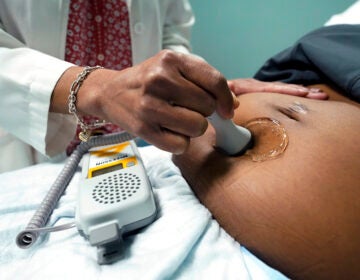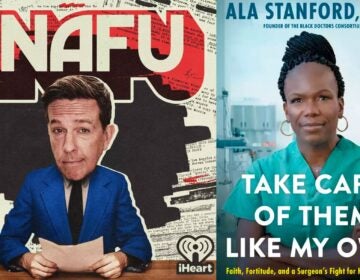How a medical student is using TikTok to bridge racial health disparities
Meet the Black TikTok creator bridging health disparities. His video convinced a woman to seek medical attention.
Listen 6:14
Medical student Joel Bervell shares important health information with Black followers on Tik Tok. (Courtesy of Joel Bervell)
This story is from The Pulse, a weekly health and science podcast.
Find it on Apple Podcasts, Spotify, or wherever you get your podcasts.
About a year ago, Lauren Bovick was on TikTok, scrolling around, when she saw something that made her pause. It was a video by Joel Bervell (@joelbervell), a Black medical student wearing scrubs, and he was talking about types of skin cancer, like melanoma. Bervell’s video explained how these cancers look different in patients of color, and he showed different images, for example, skin cancer on a patient’s foot.
Bovick’s mom is Black and her dad is white. Before she saw this video, skin cancer was not really on her radar. “I don’t typically think about getting melanoma, it’s not something that’s really on my mind since I never sunburn,” she said.
But the TikTok got her attention. And she immediately took a closer look at some spots she had seen on her foot, which she had been brushing aside as bug bites. “And I noticed that they had gotten a more mole-like appearance,” she said. “And I was like, ‘Wow, I think I need to get that checked out.’”
This is exactly what the video’s creator has in mind when making his content. Bervell is a medical student at Washington State University with a passion for bridging health disparities and providing information that is important to Black people.
His videos are simple: Bervell usually faces the camera, wearing glasses and looking serious. A music soundtrack moves things along as he points to text boxes and images, or explains a concept.
“My roommates, who are also medical students, would always tease me because they could hear me in my room talking through every single iteration of my videos that I was creating from behind closed doors,” Bervell said.
The content he makes for the platform is often based on what Bervell is learning in his ongoing medical training. The video on skin cancer was inspired by his dermatology unit. Bervell noticed that darker skin is often not represented in medical images of different types of skin cancer.
“And so I talked about that,” Bervell said. “And I think a lot of people resonate with that, there were medical students or physicians or nurses who said, ‘Yeah, when I was in school, I actually did not get that education about it.’”
Bervell says that TikTok’s algorithm is helpful to him as a content creator, as it identifies people who might have an interest in the topic. He also takes advantage of trending sounds and songs to reach wider audiences. For one of his videos, Bervell used the trending song “Still Don’t Know My Name” by Labyrinth.
@joelbervell Representation Matters in Medicine. @VisualDx created a catalogue of conditions for skin of color that makes it easier for medical professionals to determine conditions on darker skin. #dermatology #representationmatters #skin #skincare #derm #skintone ♬ Still Don’t Know My Name – Labrinth
That means Bervell’s video now comes across along with some of the most viral videos that have used this song. And if a user likes different videos that also feature that song, Bervell’s video is more likely to show up on their account, just based on that.
“I’ve always been surprised by how well that does. But I think it plays into this kind of pop culture while also bringing in medicine,” Bervell said.
Subscribe to The Pulse
He says on TikTok, people are often learning things without even realizing it. “It melds naturally into an app where you can see comedy and entertainment, but also we are getting educated at the same time.”
After Lauren Bovick saw Bervell’s video about skin cancer, she went to a dermatologist. They looked at her foot, and said it was a suspicious-looking lesion. It was biopsied, and it had not progressed to being melanoma — yet.
“It was a borderline lesion. It turned out to be precancerous,” Bovick said. “But it definitely needed to come out like it was heading in that direction.”
Bovick says that without TikTok, the lesion could have gotten worse, and turned into a cancer. She felt very grateful and she actually contacted Bervell to thank him.
“I reached out to him because I wanted him to know that he was having an impact. Because even if you put that information into the world and you hope that people act on it, you don’t necessarily think that within like a month or two someone will actually see it and be like, ‘That’s me.’”
And Bervell was grateful to hear from Bovick.
“I think stories like that as a medical student have been incredible to know that the things that I’m learning in this moment, I can transfer over to social media to share them with audiences on a larger platform and could potentially be lifesaving for someone who never knew about something like that.”
Editor’s note: This story was originally reported in the summer of 2021.
Support for WHYY’s coverage on health equity issues comes from The Commonwealth Fund.
WHYY is your source for fact-based, in-depth journalism and information. As a nonprofit organization, we rely on financial support from readers like you. Please give today.






